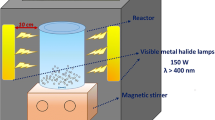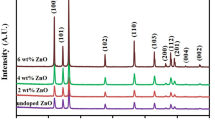Abstract
Photocatalytic degradation of broadband antibiotics like tetracycline (TC) under visible-light irradiation is considered as an efficient and cost-effective protocol for eliminating it from the aqueous medium. In this study, highly efficient solution-processable Cd1−xZnxS photocatalysts were synthesized using a simple solvothermal route where zinc acetate and cadmium acetate were used as precursors. Composition-tunable alloyed nanorods with bandgap energy tunability ranging from UV (3.7 eV) to Vis (2.5 eV) were synthesized and structural and optical characterization was performed thoroughly. With the increase of Zn content in the Cd1−xZnxS crystal, the 1LO phonon shifts notably towards higher wavenumber. The performance of Cd1−xZnxS nanorod photocatalyst is strongly related to the ratio of Cd and Zn. The Cd0.75Zn0.25S sample exhibits the highest photocatalytic degradation rate constant compared to the other family members. The scavenger experiment revealed that the holes are the main responsible species, whereas hydroxyl radicals have weak roles and electrons have mild effects for the photocatalytic degradation of TC. Our study gives new insight towards the designing of ternary photocatalytic materials for efficient removal of antibiotics from aqueous solution.




Similar content being viewed by others
References
M. Kamranifar, A. Allahresani, A. Naghizadeh, Synthesis and characterizations of a novel CoFe2O4@CuS magnetic nanocomposite and investigation of its efficiency for photocatalytic degradation of penicillin G antibiotic in simulated wastewater. J. Hazard. Mater. 366, 545–555 (2019)
L. Zhang, F. Liu, X. Xiao, X. Zuo, J. Nan, Microwave synthesis of iodine-doped bismuth oxychloride microspheres for the visible light photocatalytic removal of toxic hydroxyl-contained intermediates of parabens: catalyst synthesis, characterization, and mechanism insight. Environ. Sci. Pollut. Res. 26, 28871–28883 (2019)
R. Hao, X. Xiao, X. Zuo, J. Nan, W. Zhang, Efficient adsorption and visible-light photocatalytic degradation of tetracycline hydrochloride using mesoporous BiOI microspheres. J. Hazard. Mater. 209–210, 137–145 (2012)
J. Jeong, W. Song, W.J. Cooper, J. Jung, J. Greaves, Degradation of tetracycline antibiotics: mechanisms and kinetic studies for advanced oxidation/reduction processes. Chemosphere 78, 533–540 (2010)
S. Singh, V.C. Srivastava, I.D. Mall, Mechanism of dye degradation during electrochemical treatment. J. Phys. Chem. C 117, 15229–15240 (2013)
M.H. Khan, H. Bae, J.Y. Jung, Tetracycline degradation by ozonation in the aqueous phase: proposed degradation intermediates and pathway. J. Hazard. Mater. 181, 659–665 (2010)
M.C. Dodd, H. Kohler, U.V. Gunten, Oxidation of antibacterial compounds by ozone and hydroxyl radical: elimination of biological activity during aqueous ozonation processes. Environ. Sci. Technol. 43, 2498–2504 (2009)
C. Reyes, J. Fernández, J. Freer, M.A. Mondaca, C. Zaror, S. Malato, H.D. Mansilla, Degradation and inactivation of tetracycline by TiO2 photocatalysis. J. Photochem. Photobiol. A 184, 141–146 (2006)
C. Zhao, H. Deng, Y. Li, Z. Liu, Photodegradation of oxytetracycline in aqueous by 5A and 13X loaded with TiO2 under UV irradiation. J. Hazard. Mater. 176, 884–892 (2010)
M. Jodeyri, M. Haghighi, M. Shabani, Enhanced-photoreduction deposition of Ag over sono-dispersed C3N4-Clinoptilolite used as nanophotocatalyst for efficient photocatalytic degradation of tetracycline antibiotic under simulated solar-light. J. Mater. Sci. 30, 13877–13894 (2019)
Y. Chen, Y. Liu, X. Xie, C. Li, Y. Si, M. Zhang, Q. Yan, Synthesis flower-like BiVO4/BiOI core/shell heterostructure photocatalyst for tetracycline degradation under visible-light irradiation. J. Mater. Sci. 30, 9311–9321 (2019)
Y. Wei, J. Liang, Y. Yao, X. Xu, X. Zheng, G. He, H. Chen, Synthesis of visible light-driven graphene based ZnFe mixed metal oxide for efficient degradation of tetracycline. J. Mater. Sci. 30, 8931–8943 (2019)
R.A. Palominos, M.A. Mondaca, A. Giraldo, G. Peñuela, M. Pérez-Moya, H.D. Mansilla, Photocatalytic oxidation of the antibiotic tetracycline on TiO2 and ZnO suspensions. Catal. Today 144, 100–105 (2009)
W. Li, D. Li, J. Xian, W. Chen, Y. Hu, Y. Shao, X. Fu, Specific analyses of the active species on Zn0.28Cd0.72S and TiO2 photocatalysts in the degradation of methyl orange. J. Phys. Chem. C 114, 21482–21492 (2010)
M. Zhou, K. Xiao, X. Jiang, H. Huang, Z. Lin, J. Yao, Y. Wu, Visible-light-responsive chalcogenide photocatalyst Ba2ZnSe3:crystal and electronic structure, thermal, optical, and photocatalytic activity. Inorg. Chem. 55, 12783–12790 (2016)
S. Chakrabarty, H. Kaur, T. Pal, S. Kar, S. Ghosh, S. Ghosh, Morphology dependent photoinduced electron transfer from N, N-dimethylaniline to semiconductor cadmium sulphide. RSC Adv. 4, 35531–35540 (2014)
S. Xiang, W. Cheng, F. Chi, X. Nie, T. Hayat, N.S. Alharbi, Photocatalytic removal of U(VI) from wastewater via synergistic carbon-Supported zero-valent iron nanoparticles and S. putrefaciens. ACS Appl. Nano Mater. 3, 1131–1138 (2020)
D. Samanta, T.I. Chanu, P. Basnet, S. Chatterjee, Organic dye degradation under solar irradiation by hydrothermally synthesized ZnS nanospheres. J. Mater. Eng. Perform. 27, 2673–2678 (2018)
J. Tauc, R. Grigorovici, A. Vancu, Optical properties and electronic structure of amorphous germanium. Phys. Status Solidi 15, 627–637 (1966)
S. Sahoo, S. Dhara, V. Sivasubramanian, S. Kalavathi, A.K. Arora, Phonon confinement and substitutional disorder in Cd1−xZnxS nanocrystals. J. Raman Spectrosc. 40, 1050–1054 (2009)
Y. Wang, W. Li, Y. Feng, S. Lv, M. Li, Z. Li, Nitrogen ion irradiation effect on enhancing photocatalytic performance of CdTe/ZnO hetero structures. Front. Mater. Sci. 12, 392–404 (2018)
S. Ibrahim, T. Pal, S. Ghosh, Sonochemical functionalization of MoS2 by zinc phthalocyanine and its visible light induced photocatalytic activity. New J. Chem. 43, 10118–10125 (2019)
K. Chakraborty, S. Ghosh, T. Pal, Reduced-graphene-oxide zinc-telluride composite: towards large-area optoelectronic and photocatalytic applications. ChemistrySelect 3, 8637–8643 (2018)
K. Chakraborty, S. Ibrahim, P. Das, S. Ghosh, T. Pal, Solar light responsive photocatalytic activity of reduced graphene oxide–zinc selenide nanocomposite. J. Mater. Eng. Perform. 27, 2617–2621 (2018)
K. Chakraborty, S. Chakrabarty, T. Pal, S. Ghosh, Synergistic effect of zinc selenide - reduced graphene oxide towards enhanced solar-light-responsive photo current generation and photocatalytic 4-Nitrophenol degradation. New J. Chem. 41, 4662–4671 (2017)
Y. Liu, X. Gan, B. Zhou, B. Xiong, J. Li, C. Dong, J. Bai, W. Cai, Photoelectrocatalytic degradation of tetracycline by highly effective TiO2 nanopore arrays electrode. J. Hazard. Mater. 171, 678–683 (2009)
Acknowledgements
This work was supported by the Department of Science and Technology (DST), New Delhi, India via Grant SR/FTP/PS-113/2010, and University Grant Commission (UGC), New Delhi, India via Grant PSW-059/13-14. We are also thankful to the UGC and DST, for providing special assistance and infrastructural support to the Department of Physics, Vidyasagar University, via the SAP and FIST programs, respectively.
Author information
Authors and Affiliations
Corresponding author
Additional information
Publisher's Note
Springer Nature remains neutral with regard to jurisdictional claims in published maps and institutional affiliations.
Electronic supplementary material
Below is the link to the electronic supplementary material.
Rights and permissions
About this article
Cite this article
Ibrahim, S., Ghosh, S. & Pal, T. Synthesis and characterization of solution-processable Cd1–xZnxS nanorods for photocatalytic degradation of tetracycline. J Mater Sci: Mater Electron 31, 12955–12960 (2020). https://doi.org/10.1007/s10854-020-03848-z
Received:
Accepted:
Published:
Issue Date:
DOI: https://doi.org/10.1007/s10854-020-03848-z




